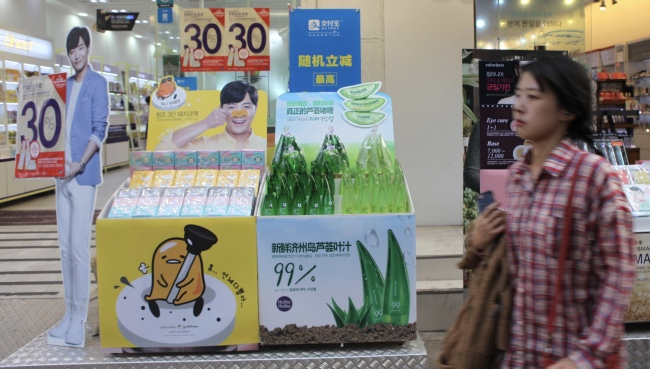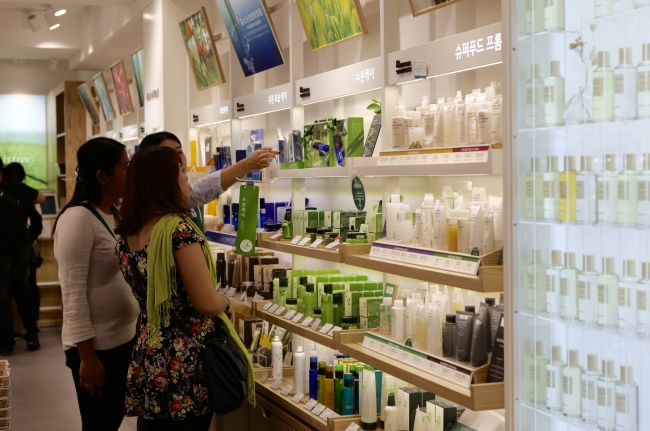[FEATURE] Cashing in on the Jeju name
Calls for more control from provincial government, amid deceptive product labeling and lack of contribution to local economy
By Park Ga-youngPublished : Oct. 16, 2016 - 16:59
Samdasoo, a mineral water brand that hails from Jejudo, has been the undisputed No. 1 in Korea’s bottled water market for almost 20 years.
It rides on the reputation of South Korea’s biggest island, which over the years has transformed into a resort area attracting more than 16 million tourists each year. Its pristine environment and scenic views has also turned it into a destination where throngs of tired urbanites relocate in search of peace.
It rides on the reputation of South Korea’s biggest island, which over the years has transformed into a resort area attracting more than 16 million tourists each year. Its pristine environment and scenic views has also turned it into a destination where throngs of tired urbanites relocate in search of peace.

As Jejudo’s popularity grew, so did its brand value, to the point that its name is now being used for products that have very little to do with the island itself.
Recently, there have been a number of such products -- especially cosmetics -- using the Jejudo name for their packaging and marketing. And the island’s government is now stepping up to put the brakes on such usage.
In May this year, the Jeju Special Self-governing Province began a non-mandatory certificate program in an effort to curb misuse of the island’s image.
The certificate “Made in Jeju” is bestowed only to environment-friendly products that are manufactured in Jeju with at least 10 percent of the ingredients produced on the island.
“(Taking advantage of Jeju’s brand) has been around for quite a while,” said Song Pil-ho, the province’s official in charge of the cosmetic certificate program.
“In addition to domestic companies that have little to do with Jeju, there were even foreign firms falsely claiming their cosmetic products were ‘made in Jeju’ during exhibitions.”
For businesspeople in the beauty industry, where lowering costs is critical to offset hefty marketing budgets, using the Jejudo brand is an attractive option and has a proven track record.
The success of Innisfree, an AmorePacific brand, came as a result of the company re-establishing its brand concept to “Natural Benefit from Jeju” in 2010, 10 years after its launch.
Innisfree has since introduced products featuring Jeju green tea, Jeju volcanic rock, Jeju orchid and lava seawater.
Innisfree’s success was benchmarked by other brands, leading to launches of various products inspired by Jejudo, such as those featuring Jeju horse oil cream. Now it is difficult to keep track of the number of cosmetic brands and products leveraging on the name of Jejudo.

Behind such product launches is an unprecedented demand for beauty products that emphasize nature and cleanness, especially from China.
Representatives from big cosmetics companies such as AmorePacific and LG Household and Health say their Jeju-themed items do not necessarily target Chinese consumers, but smaller cosmetics companies appear to be tying their fate to the burgeoning demand for products in Asia’s biggest economy, where many of its citizens suffer from pollution.
“Demand for Jeju-themed products has been increasing rapidly from China over the last two to three years,” Han Seok-hun, an employee of a cosmetics company told The Korea Herald. The company has two out of its seven brands focusing on Jeju-related cosmetics.
A businesswoman surnamed Ham agreed that there is definitely growing Chinese demand for products from Jejudo. Earlier this month, her company introduced a series of products featuring Jejudo, which are provided exclusively to a vendor in China.
While Jejudo is an attractive marketing tool, the cost of making a truly Jeju-product is not.
It usually costs about an additional 30 percent on average to manufacture cosmetic goods on the island due to reasons such as logistics, according to a salesperson of a company that specializes in original design manufacturing. His company has a factory on Jejudo and makes products for other cosmetics companies.
He said Jejudo products can range from those entirely produced on the island using local ingredients to those that only take on the concept of the island and partially use Jejudo ingredients such as water.
Industry experts, including Han and other insiders interviewed by The Korea Herald, said transportation fees and scarcity of resources on the under 1,850-square-kilometer island are the biggest cost factors.
As a result, it has become common to see deceptive labeling that takes advantage of the Jejudo brand in the absence of strict regulation.
For instance, a line of facial masks produced by a major cosmetics company is marketed with images of Jejudo and its local ingredients -- such as barley, seaweed, camellia leaves and tangerine -- on its packaging. In reality, the product is produced in a factory in North Chungcheong Province and contains less than 0.2 percent of Jejudo ingredients.
In the case of Innisfree products, while their featured ingredients are from Jejudo, only a handful of the products are actually manufactured there.
Other products and brands are similar.
So far, only 50 products from 10 brands have been awarded the Jeju cosmetic certificate, statistics from the Jeju government showed.
The Jeju municipal government is aware that the misuse of the island’s image brings little benefit to the local economy and does not create many jobs as most production takes place elsewhere.
“Take Jeju pork as an example. It’s expensive outside Jeju but there are countless restaurants that claim to sell Jeju pork even if they are not authentic, which hurts the image of Jeju Island,” Song said. “So it is important we put a stop to the misuse of Jeju’s image.”
Despite the country’s overall sluggish economic growth, Jejudo has seen “explosive growth,” according to Gov. Won Hee-ryong.
Jeju’s gross regional domestic product grew from 10.89 trillion won ($9.5 billion) in 2010 to 14.75 trillion in 2015, while the population reached 650,000 this year, several years faster than the local government’s initial forecast.
Meanwhile, many Jejudo residents feel they are not benefitting from such growth, as tourism and the Jejudo brand have not translated into income for them. The average monthly income of the island’s residents remained the lowest among 16 South Korean regions, at 2.45 million won in 2015.
The importance and potential of the Jejudo brand have been discussed and researched by the community there, including its government, academics and businesses, for many years.
Scholars published articles on strategies for branding the island in the early 2010s and the government formed a task force on Jejudo’s global branding in 2012.
There has been some improvement since then.
Last year, a new tangerine brand was formed by merging 37 of more than 90 different tangerine brands on Jejudo.
A group of small and mid-sized companies called “It’s Jeju” has grown to include 126 companies with 700 products after starting with just five members a decade ago.
The cosmetic certificate program is alo a result of these efforts to develop and promote authentic Jejudo brands such as Samdasoo, which is manufactured by the Jeju Special Self-Governing Province Development Corp.
“We don’t want to stop companies that claim a Jeju pedigree for their products, but we want to encourage them to use this certificate system to boost the credibility of their products while contributing to the local economy,” Song said.
Several departments of the Jeju government are currently in the process of adopting similar certificate programs for agricultural products and other items, according to Jeju government officials.
These are meaningful developments to build and protect the name of Jejudo, but these efforts are still bogged down by inconsistencies, according to Kim Hyoung-gil, a business professor at Jeju National University.
Kim, who published articles on problems with Jejudo brands in the early 2010s, said the problems that existed several years ago are still prevalent.
“Each department of the Jeju government, each province, or each business association is doing their own thing to develop brand Jeju,” Kim said. “There is ‘It’s Jeju,’ but there are also similar provincial organizations just like that, which I think is unnecessary.”
“There needs to be one comprehensive organization that oversees all activities related to developing brand Jeju. It’s way too scattered now,” Kim said.
By Park Ga-young (gypark@heraldcorp.com)



















![[Today’s K-pop] Treasure to publish magazine for debut anniversary](http://res.heraldm.com/phpwas/restmb_idxmake.php?idx=642&simg=/content/image/2024/07/26/20240726050551_0.jpg&u=)